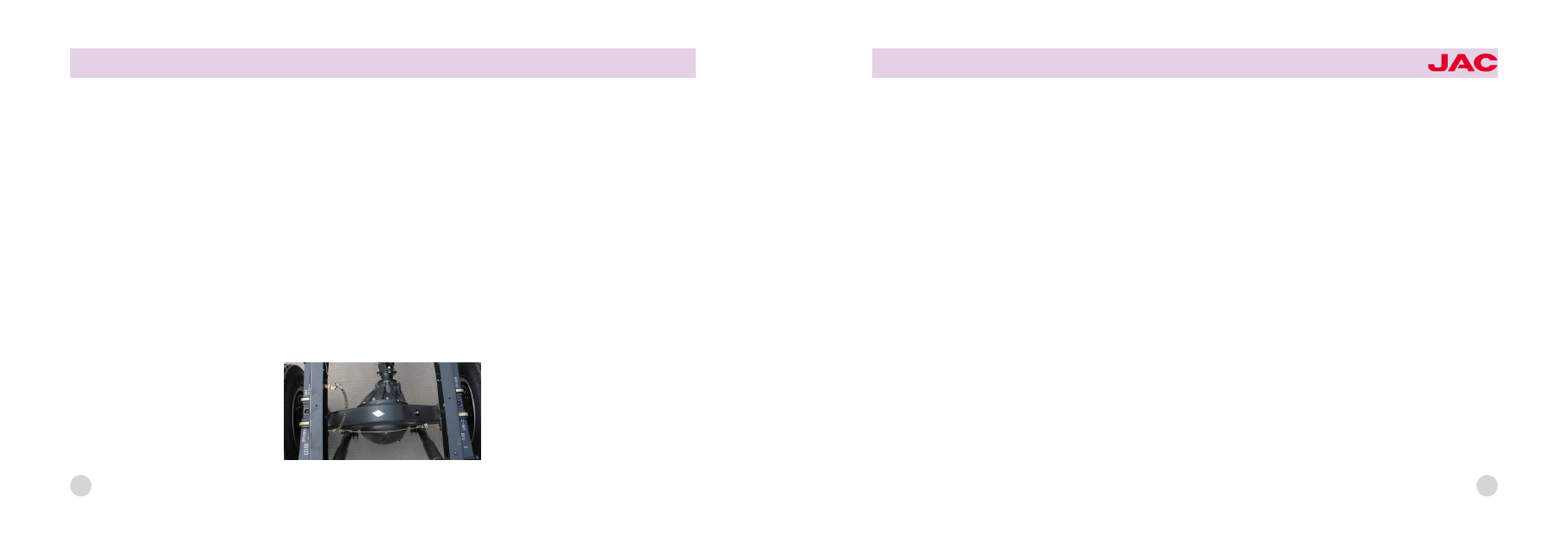JAC Trucks. Service manual - part 117

riv eted effectively. Spline spindles
are welded to the front side of the
drive shaft of the rear axle, to which
universal joints are installed, so that
the drive shaft can flex and circum鄄
volve freely. The splines adopt invo鄄
lute type and clearance between
teeth is small, which can decrease
impact effectively as rotate speed of
the drive shaft changes.
2. Using and inspection
1) Drive shaft has been counter鄄
poised in factory, it should be en鄄
sured not to impact in use and not to
knock and stack in disassembly and
carry. Replace for a new one if the
shaft is distorted or the balancer is
desquamated, otherwise there will be
vibration, noise, and extra impact in
travel, which can damage other as鄄
semblies and even endanger driving.
2) Check oil seals of center support鄄
ing bearing, needle bearing of cross
shaft, sliding spline regularly, replace
invalid oil seals instantly.
渊IV冤Rear axle
1. Brief description of structure
Rear axle that adopts single deceler鄄
ating is the driving axle and is com鄄
posed of master retarder, differential
and axle housing; rear axle is also the
final part of transmission system of
the truck. Master retarder can not on鄄
ly change the direction of driving
force, but also reduce the rotate
speed. It is composed of driving gear
and driven gear which join together.
The end with splines of the driving
gear is connected with universal joint
assembly by coupling flange. Shaft
neck with small end of the driving
gear is mounted to guide cylindrical
roller bearing and bears radial force
only. Driven gear is also called crown
gear and is fixed to left half flange of
the differential case with bolts. Differ鄄
ential that is composed of differential
case, cross shaft and four planetary
pinions is a device that makes the left
wheel and the right wheel run at a
different speed when necessary. Rear
axle housing is an integrated axle
housing that is made of welding
punched armor plate.
44
45
2. Using and inspection
1) Lubricate to hyperbola bevel gear
requires highly, only specified gear
oil is allowed to fill into the axle
housing, and other gear oil can not
be used, or it will result in quickened
scratch and wearing of the gear sur鄄
face.
2) It爷s unnecessary to remove or ad鄄
just the conical gears and bearings
of master retarder of the rear axle, for
they have been matched and adjust鄄
ed in factory. Removing and adjust鄄
ing should be done only as the gears
are worn and the gear clearance is
beyond the specified value or the
bearing axial clearance is too large,
or the damaged parts must be re鄄
placed.
3) Clean the vent plug regularly to
make sure that ventilation is expe鄄
dite. A jammed air drain can bring
higher air pressure in the rear axle,
which will result in oil leak at the
joints and the driving gear oil seal.
4) Check the lubricant level in the
axle housing regularly. Check quality
of the lubricant regularly, and replace
for new lubricant if the chroma and
viscosity is abnormal.
渊V冤Suspension
1. Brief description of structure
Suspension system is made up of
leaf spring, two -direction hydraulic
shock absorber and cushion block
etc. Rear leaf spring adopts main
and auxiliary leaf springs, which im鄄
proves smoothness.
2. Using and maintenance of leaf
spring
1) When the vehicle has run for
200km and 500km in breaking -in
period, check and tighten U -bolts
and U -nuts of the leaf spring ac鄄
cording
to
specified
tightening
torque, as the vehicle is under load鄄
ing.
2) After breaking -in period or the
leaf spring is replaced and new one
is installed, check and tighten
U -bolts and U -nuts of the leaf
spring according to specified tighten鄄
ing torque, as the vehicle is fully
loaded.
3) After every 2000要3000km in run鄄
ning, check and tighten U-bolts and
U -nuts of the leaf spring according
HFC1045
series trucks